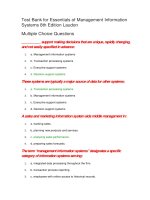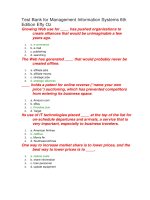Enterprise manage information systems 6th by laudon ch05
Bạn đang xem bản rút gọn của tài liệu. Xem và tải ngay bản đầy đủ của tài liệu tại đây (514.82 KB, 51 trang )
Chapter 5
Essentials of Management Information Systems, 6e
Chapter 5 Ethical and Social Issues in the Digital Firm
Ethical and Social Issues in the
Digital Firm
5.1
© 2005 by Prentice Hall
Essentials of Management Information Systems, 6e
Chapter 5 Ethical and Social Issues in the Digital Firm
Objectives
1. What ethical, social, and political issues are raised
by information systems?
2. Are there specific principles for conduct that can
be used to guide decisions about ethical dilemmas?
3. Why does contemporary information systems
technology pose challenges to the protection of
individual privacy and intellectual property?
5.2
© 2005 by Prentice Hall
Essentials of Management Information Systems, 6e
Chapter 5 Ethical and Social Issues in the Digital Firm
Objectives
4. How have information systems affected
everyday life?
5. How can organizations develop corporate
policies for ethical conduct?
5.3
© 2005 by Prentice Hall
Essentials of Management Information Systems, 6e
Chapter 5 Ethical and Social Issues in the Digital Firm
Management Challenges
1. Understanding the moral risks of new
technology
2. Establishing corporate ethics policies that
include information systems issues
5.4
© 2005 by Prentice Hall
Essentials of Management Information Systems, 6e
Chapter 5 Ethical and Social Issues in the Digital Firm
Understanding Ethical and Social Issues Related to Systems
A Model for Thinking About Ethical, Social, and Political Issues
• Ethics: Principles of right and wrong that can be
used by individuals acting as free moral agents to
make choices to guide their behavior
• View shock of new information technology as a
“rock thrown into a pond.”
5.5
© 2005 by Prentice Hall
Essentials of Management Information Systems, 6e
Chapter 5 Ethical and Social Issues in the Digital Firm
Understanding Ethical and Social Issues Related to Systems
The relationship between ethical, social, and political issues
in an information society
Figure 5-1
5.6
© 2005 by Prentice Hall
Essentials of Management Information Systems, 6e
Chapter 5 Ethical and Social Issues in the Digital Firm
Understanding Ethical and Social Issues Related to Systems
Moral Dimensions of the Information Age
• Information rights and obligations
• Property rights and obligations
• Accountability and control
• System quality
• Quality of life
5.7
© 2005 by Prentice Hall
Essentials of Management Information Systems, 6e
Chapter 5 Ethical and Social Issues in the Digital Firm
Understanding Ethical and Social Issues Related to Systems
Key Technology Trends that Raise Ethical Issues
• Computing power doubles every month
• Rapidly declining data storage costs
• Data analysis advances
• Networking advances and the Internet
5.8
© 2005 by Prentice Hall
Essentials of Management Information Systems, 6e
Chapter 5 Ethical and Social Issues in the Digital Firm
Understanding Ethical and Social Issues Related to Systems
Key Technology Trends that Raise Ethical Issues
• Profiling: use of computers to combine data from
multiple sources and create electronic dossiers of
detailed information on individuals
• NORA (nonobvious relationship awareness): new
data analysis technique for even more powerful
profiling
5.9
© 2005 by Prentice Hall
Essentials of Management Information Systems, 6e
Chapter 5 Ethical and Social Issues in the Digital Firm
Understanding Ethical and Social Issues Related to Systems
Nonobvious relationship awareness (NORA)
Figure 5-2
5.10
© 2005 by Prentice Hall
Essentials of Management Information Systems, 6e
Chapter 5 Ethical and Social Issues in the Digital Firm
Ethics in an Information Society
Basic Concepts
• Responsibility
• Accountability
• Liability
• Due process
5.11
© 2005 by Prentice Hall
Essentials of Management Information Systems, 6e
Chapter 5 Ethical and Social Issues in the Digital Firm
Ethics in an Information Society
Basic Concepts
1. Information technologies are filtered through
social institutions, organizations, individuals
2. Responsibility falls on institutions, organizations,
and individuals who choose to use the technology
3. In an ethical, political society, individuals and
others can recover damages done to them through
a set of laws
5.12
© 2005 by Prentice Hall
Essentials of Management Information Systems, 6e
Chapter 5 Ethical and Social Issues in the Digital Firm
Ethics in an Information Society
Ethical Analysis
Five-step Process for Analysis
1. Identify and describe clearly the facts
2. Define the conflict and identify the higher-order
values involved
3. Identify the stakeholders
4. Identify reasonable options
5. Identify potential consequences of these options
5.13
© 2005 by Prentice Hall
Essentials of Management Information Systems, 6e
Chapter 5 Ethical and Social Issues in the Digital Firm
Ethics in an Information Society
Ethical Analysis
Candidate Ethical Principles
1.
2.
3.
4.
5.
6.
5.14
The “Golden Rule”
Kant’s Categorical Imperative
Descarte’s rule of change
The Utilitarian Principle
The Risk Aversion Principle
Ethical “no free lunch” rule
© 2005 by Prentice Hall
Essentials of Management Information Systems, 6e
Chapter 5 Ethical and Social Issues in the Digital Firm
Ethics in an Information Society
Professional Codes of Conduct
•
Codes of ethics: promises by professions to
regulate themselves in the general interest of
society.
•
Promulgated by professional associations such
as American Medical Association (AMA).
•
Association of Computing Machinery (ACM)
“General Moral Imperatives” include honoring
property rights and respecting privacy.
5.15
© 2005 by Prentice Hall
Essentials of Management Information Systems, 6e
Chapter 5 Ethical and Social Issues in the Digital Firm
Ethics in an Information Society
Some Real-World Ethical Dilemmas
•
Competing values: one set of interests pitted
against another
•
E-mail monitoring at the workplace
•
Use of new technology to reduce workforce and
lower costs
5.16
© 2005 by Prentice Hall
Essentials of Management Information Systems, 6e
Chapter 5 Ethical and Social Issues in the Digital Firm
The Moral Dimensions of Information Systems
Information Rights: Privacy and Freedom in the Internet Age
•
Privacy: Claim of individuals to be left alone,
free from surveillance or interference from other
individuals, organizations, or the state.
•
Protected primarily in United States by First
Amendment, Fourth Amendment, and Privacy
Act of 1974
•
Today, most U.S. federal privacy laws apply
only to federal government, not to private sector
5.17
© 2005 by Prentice Hall
Essentials of Management Information Systems, 6e
Chapter 5 Ethical and Social Issues in the Digital Firm
The Moral Dimensions of Information Systems
Federal Privacy Laws in the United States
General Federal Privacy Laws
•
•
•
•
•
•
5.18
Freedom of Information Act, 1966
Privacy Act of 1974
Electronic Communications Privacy Act of 1986
Computer Matching and Privacy Protection Act of 1988
Computer Security Act of 1987
Federal Managers Financial Integrity Act of 1982
© 2005 by Prentice Hall
Essentials of Management Information Systems, 6e
Chapter 5 Ethical and Social Issues in the Digital Firm
The Moral Dimensions of Information Systems
Federal Privacy Laws in the United States
Privacy Laws Affecting Private Institutions
•
•
•
•
•
•
•
•
•
•
5.19
Fair Credit Reporting Act of 1970
Family Educational Rights and Privacy Act of 1974
Right to Financial Privacy Act of 1978
Privacy Protection Act of 1980
Cable Communications Policy Act of 1984
Electronic Communications Privacy Act of 1986
Video Privacy Protection Act of 1988
The Health Insurance Portability and Accountability Act of 1996
Children’s Online Privacy Protection Act of 1998
Financial Modernization Act (Gramm-Leach-Bliley Act) of 1999
© 2005 by Prentice Hall
Essentials of Management Information Systems, 6e
Chapter 5 Ethical and Social Issues in the Digital Firm
The Moral Dimensions of Information Systems
Information Rights: Privacy and Freedom in the Internet Age
Fair Information Practices (FIP)
•
Set of principles governing the collection and use of
information about individuals, set forth in 1973 federal
government report
•
Forms basis of most American and European privacy law
•
Extended in 1998 by FTC to provide guidelines for
online privacy
5.20
© 2005 by Prentice Hall
Essentials of Management Information Systems, 6e
Chapter 5 Ethical and Social Issues in the Digital Firm
The Moral Dimensions of Information Systems
Information Rights: Privacy and Freedom in the Internet Age
Federal Trade Commission
Fair Information Practices Principles
1.
2.
3.
4.
5.
5.21
Notice/Awareness (core principle)
Choice/Consent (core principle)
Access/Participation
Security
Enforcement
© 2005 by Prentice Hall
Essentials of Management Information Systems, 6e
Chapter 5 Ethical and Social Issues in the Digital Firm
The Moral Dimensions of Information Systems
Information Rights: Privacy and Freedom in the Internet Age
European Commission’s
Directive on Data Protection (1998)
•
•
•
•
•
5.22
More stringent than the United States
Requires companies to inform people of data collection
and storage
Customers must provide informed consent
Disallows transferring of data to countries without
similar laws
U.S. “safe harbor” developed with U.S. Department of
Commerce
© 2005 by Prentice Hall
Essentials of Management Information Systems, 6e
Chapter 5 Ethical and Social Issues in the Digital Firm
The Moral Dimensions of Information Systems
Information Rights: Privacy and Freedom in the Internet Age
Internet Challenges to Privacy
•
•
•
•
•
5.23
Computer systems able to monitor, capture, store
communications passing through
Monitoring tools
Cookies
Web bugs
Spyware
© 2005 by Prentice Hall
Essentials of Management Information Systems, 6e
Chapter 5 Ethical and Social Issues in the Digital Firm
The Moral Dimensions of Information Systems
How cookies identify Web visitors
Figure 5-3
5.24
© 2005 by Prentice Hall
Essentials of Management Information Systems, 6e
Chapter 5 Ethical and Social Issues in the Digital Firm
The Moral Dimensions of Information Systems
Information Rights: Privacy and Freedom in the Internet Age
U.S. Online Industry Self-Regulation
•
•
•
•
•
5.25
Statements of information use
Opt-out model
Opt-in model
Online Privacy Alliance
Network Advertising Initiative (NAI)
© 2005 by Prentice Hall









